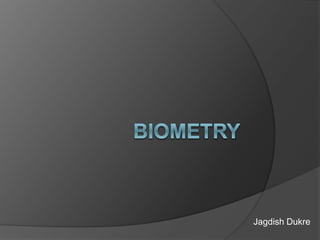
Biometry
- 2. Biometry is the process of measuring the power of the cornea (keratometry) and the Axial length of the eye, and using this data to determine the ideal intraocular lens power.
- 3. Measuring the axial length of the eye Axial length of the eye is measured with A scan ultrasonography. An 1-mm error in measurement of axial length produces an error of 3 D in IOL calculation.
- 4. For accurate measurement of axial length (using applanation): ensure the machine is calibrated and set for the correct velocity setting (e.g. cataract, aphakia, pseudophakia) take care with axial alignment, especially with a hand-held probe and a moving patient.
- 5. the gain should be set at the lowest level at which a good reading is obtained. don’t push too hard – corneal compression commonly causes errors. the echoes from cornea, anterior lens, posterior lens, and retina should be present and of good amplitude misalignment along the optic nerve is recognised by an absent scleral spike. average the 5-10 most consistent results giving the lowest standard deviation (ideally < 0.06 mm) errors may arise from an insufficient or greasy corneal meniscus due to ointment or methylcellulose used previously.
- 6. Measuring the power of the cornea Keratometry may be carried out manually or using an automated or hand-held device. Accuracy is essential, as an error of 0.75 D in the keratometry will result in a similar post-operative error.
- 7. For accurate manual keratometry : ensure a good tear film adjust the eyepiece to bring the central cross-hairs into focus. make sure that the patient’s other eye is occluded and that the cornea is centred take an average of three readings. if high or low results are encountered (< 40.00 D or > 48.00 D), it is advisable to have a second check. repeat if the difference in total keratometric power between the eyes exceeds 1.50 D in a scarred cornea, use the fellow eye or average the results.
- 8. IOL Formulae First generation Second generation Third generation Fourth generation
- 9. First generation Theoretical 1. Binkhorst 2. Colenbrander-Hoffer 3. Gilll’s 4. Clayman 5. Fyodorov Regression SRK - I
- 10. Second generation Theoretical Modified Binkhorst Regression SRK - II
- 11. Third generation Holladay I SRK/T Hoffer Q
- 12. Fourth generation Holladay - II
- 13. Biometry after keratorefractive surgery Anterior surface is flattened with no change in the posterior radius. This causes error in keratometry leading to hyperopic IOL estimation.
- 14. The methods to calculate K values in a Post LASIK eye: Clinical history Contact lens correction Topography
- 15. Clinical history It is considered the gold standard. For this method, keratometric values and the manifest refraction (MR) from before the refractive surgery as well as MR at appropriate intervals after the refractive procedure are needed. The data is used to calculate the change in MR from pre to post refractive surgery
- 16. That value is subtracted from the original keratometric value to obtain the “effective Keratometric Value” for use in IOL power calculation. In this method the post-op MR value that should be used is the most recent one obtained before Cataract development as refraction is effected by the lens change.
- 17. Contact lens correction It is based on the principle that if a contact lens of base curve(B) is equal effective power of the cornea then there would be no change in the refractive error with/without the contact lens.
- 18. Topography This is not very accurate. This is used when Preop ‘K’ is not known in a dense cataract patient. A CVK derived mean anterior corneal curvature value calculated for a specific 3 mm central region of cornea, modified based on the amount of surgicallyinduced refraction change, is used. But this is not as accurate as other techniques; because ablative procedure changes standardised index of Refraction (SIR). There is 1D overestimation for change of 7D during the refractive surgery.
- 19. Pediatric biometry Pediatric eye is not a miniaturized adult eye. It has shorter axial length, steeper cornea with higher keratometry value and smaller anterior chamber depth. Errors in axial length measurement affect IOL power calculation the most, it increases to 3.75 D per mm in children. In small eyes with congenital cataract the lens is a greater proportion of the total axial length and therefore the average velocity would be faster.
- 20. no formula has been proven to have an advantage over others. newer theoretic formulas such as Holladay II that take anterior segment measurements into account, may be recommended for pediatric IOL power calculation. 20% undercorrection if the child is less than age 2 years 10% undercorrection for age 2–8 years .
- 22. Biometry in aphakia Two lens spikes are absent Velocity is decreased
- 23. Biometry in pseudophakia High spike at the lens Holladay formula TAL = 0.988(AAL) + T[1-(1532/V)]
- 24. Secondary piggyback IOL Only refractive error is required. Holladay Refractive formula Hyperopic error : piggyback IOL = 1.5 x R Myopic error : piggyback IOL = 1 x R Where R = postoperative spherical equivalent refractive error.
- 25. THANK YOU
Notes de l'éditeur
- with an average error of 2.5 D per millimeter of axial length in adults;
